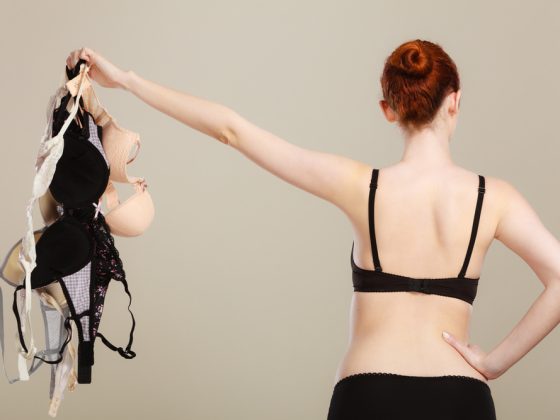When it comes to wearing business or formal attire, nothing is more important than getting the right measurements for your suit or blouse.
As a woman, getting the right measurements can mean the difference between feeling confident and comfortable in your suit or blouse or not.
Fortunately, it’s easy to measure yourself for a well-fitting suit and blouse.
If you’re measuring your arms for a suit or blouse, the average sleeve length for a woman is anywhere between 30 to 31 inches.
You should get the help of a tailor if you’re unsure of how to size yourself.
The best way to measure your arm for your next suit is with their help or by using a tape measure or an old blouse.
Table of Contents
Why Measure Your Arms?

Before buying a suit, whether at a tailor, at a department store, or online, it’s important to have the right measurements so you know that a suit will fit you well.
Measuring your arms is one of the best ways to choose a blouse or blazer that fits you.
The arms run parallel to the body, meaning that too short of a measurement for your arms will make your suit, blazer, or blouse ride up.
Too long of a measurement will make it impossible to use cufflinks or properly style your blazer with accessories.
Baggy sleeves can also be dangerous. For instance, if you wear a suit due to being a detective, or you have to be well-fitted because you’re a doctor out in the medical field, these are all instances in which measuring your arms will matter.
That’s why even military uniforms are fitted properly to make sure your sleeves are not too short or too long to impede your comfort and daily duties.
Does a Tailored Suit or Blouse Matter?

First impressions matter! In fact, according to the American Psychological Association, first impressions matter as much, if not more, than your actual ideas.
This might seem like an archaic way of thinking, especially with so much liberty in the workplace to dress how you want, be yourself, and ultimately choose your own style.
Modern Dress Codes
Unfortunately, not all work or business environments are adapted to such liberties.
For some men and women, wearing a tailored suit or outfit is not only a way to look and feel great, but is also necessary in order to seem professional and get ahead.
Don’t worry, it isn’t all bad! There are certainly affordable blouses and suits that you can purchase online, so long as you get the appropriate measurements.
In fact, up to 42% of people in 2021 returned their clothing due to size and fitting issues.
This is why it’s so important to get the appropriate size for your arms.
Doing so can help save you money on professional, business-style clothing, while also helping you feel confident, look your best, and feel comfortable – even during those nerve-wracking meetings.
How Long are the Average Woman’s Arms?

It might seem simple to measure your arms. All you need is a ruler to measure from your shoulder down to your wrist, right? Not quite.
Tailored suits and blouses are a bit different. Although the average woman’s arms are estimated to be around 36cm in length (around 14 inches), this is, of course, not the standard for everyone.
In addition to having longer or shorter arms depending on torso size, different lengths, and even deformities, women might also have two different lengths in their arms.
This means that their right arm might be a bit longer or shorter than their left arm.
Fortunately, this isn’t an all-too-common issue and is one that isn’t too dramatic unless a woman has scoliosis or another birth defect.
How Tailors Measure the Average Length of Woman’s Arms

If the average size of a woman’s arms is around 36cm or 14 inches, then how is the average length of a woman’s arms 30 to 31 inches according to dress shirt sizes?
The answer is because of the way the arms are measured for a dress shirt, blazer, or suit.
It is quite different than simply taking a tape measure and measuring from your shoulder to just above your wrist.
To take a measurement of your arms for a dress shirt or suit:
1. Measure from the center of the neck or back to the end of the shoulder.
2. Measure from the top of the shoulder at the very center down to the wrist.
3. Make sure to keep the arm slightly bent when measuring for a dress shirt or blouse. This will allow you more room for comfort.
4. Take the total of the two measurements and add them to the nearest 1/2-inch measurement.
As you can see from this form of measuring, you’ll need to add on the length of the shoulder from the tip to the end of your clavicle (collar bone).
This measurement will vary widely with women, as it can depend on several factors, including:
- How small or large your trapezius and neck muscles are. If you love to work out, this shoulder area might be large.
- The size of your bust and how it affects the total shoulder length.
- If there are any size differences from side of the shoulder or neck to the other.
Tools to Measure your Arms

There are various ways to measure your arms.
However, by far the best method is to use a tape measure that is flexible enough and long enough to drape over your shoulders down to your wrist.
A tape measure is better than using a straight edge since we all have a natural curve at our shoulders.
Just look at the mirror and examine the way your shoulders droop down. There is a gradual curve instead of a perfect 90-degree angle.
This means that you will need to use a flexible tape measure that can be laid on this curve and take into account an accurate measurement.
If you don’t have a tape measure available or a partner to help you take accurate measurements, some other methods to measure your arms include the following.
Use an Old Blouse
Take a blouse, blazer, or suit that fits you perfectly already and check the measurement of the sleeve.
You can lay it on a flat surface and then use a tape measure to take measurements alone.
Then, use these sleeve length measurements to buy another blouse or blazer, comparing your measurements to the brand you are buying from.
Remember, high-end luxury brands that sell dress shirts or blazers have very specific measurements, so it’s best to view their unique sizing charts before making a purchase.
Use a String

If you don’t have a tape measure at the moment, you can also take a piece of string or even a shoelace and use it to measure from the nape of your neck to the shoulder, and from your shoulder down.
Then, you can lay this string down and measure it using a tape measure or flat ruler.
Visit a Tailor
Many tailors and seamstresses are fairly affordable to visit.
You can schedule an appointment simply for measurements and your tailor will give you the best fitting and advice on what suits, dress shirts, and blazers to purchase.
How Long Should My Sleeves Be?

For women, the length of your sleeve definitely matters to help you feel comfortable and help you accessorize.
If you want to add a flair of style, there are also different sleeve lengths to choose from, including:
- Camp Sleeve: This is also known as a short-sleeve, and it is a fashionable and fun way to be business casual during the summer. The best-fitting camp sleeve shirts will allow you to have enough room to move your bicep freely and will fall around half of the way down between your shoulder and the inner part of your elbow.
- 3/4 Sleeve: As the name suggests, these types of sleeves run all the way down to the mid part of the forearm. They fit perfectly onto the forearm, creating a shirt that is fun and flowing and perfect for that spring or early summer heat. 3/4 sleeves will be different for everyone, but just remember that they are not supposed to go more than halfway down your forearm.
- Long or Fitted Sleeve: This is the sleeve most people think of when they think of a dress shirt. These shirts might also include different types of wrist fittings, such as cuff links, French, or even gauntlet style sleeves. Your tailor will measure your arm depending on where the end of the sleeve will fall. However, as a general rule of thumb, the end of the sleeve should sit just below your wrist.
What About Blouse Sleeves?

These measurements are specific for dress shirts and blazers. However, some women might prefer to go without dress shirts at all and stick to blouses.
This is also fine to wear in the workplace, especially blouses that have muted and neutral colors.
If you plan on wearing a blouse and are wondering how to measure the sleeve length for a blouse, you’re in luck.
Most blouses do not have specific sleeve measurements.
However, they will come in traditional sizes (extra-small, small, medium, large, extra-large, etc.), though these will also vary according to the brand you’re wearing.
Blouses are, therefore, less of a hassle to measure for, yet still quite beautiful and professional.
The sleeve lengths on these will depend on the actual overall size of the shirt, although you can shop for “petite” sizes which generally have smaller sleeve lengths.
Final Thoughts
It’s fairly easy to measure your arms appropriately for your next dress suit, blazer, or suit.
Use the proper tools such as a tape measure or take an old blouse if it makes things easier.
Whichever method you choose, remember to aim for the best fit and best comfort.
After you have your measurements, use these key details to purchase the best fitting suit or dress shirt of your life, and exude confidence anywhere!




